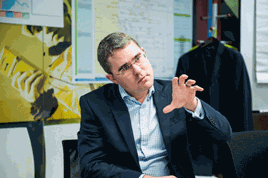Despite being carried out above ground and largely along existing routes, the work being done on the surface sections is nevertheless complex. And it has now reached its own milestone of being 50% complete, and entirely to schedule.
“We deal with improvements to the existing railway, either side of the tunnels, and I am in overall charge of that,” Steele explains.
“There are three big challenges that come with that: integrating multi-disciplinary work together; doing all the work around the operational railway; and, as we do all that in a hazardous environment, making sure our passengers and staff are kept safe.
“We are doing this on two of the busiest routes into London. They are extremely busy commuter and long-distance routes, and to build Crossrail around those is a huge challenge.”
Multi-disciplinary it certainly is. In addition to trackwork, Steele and his 3,000-strong team of engineers and subcontractors must resignal the entire route to increase capacity, install overhead wires beyond their current limit at Heathrow (Stockley) Junction to Reading, and extend existing platforms to accommodate new 240-metre trains.
NR teams have also built two large structures in west London to grade separate bottleneck junctions and to reduce conflicting movements once Crossrail traffic is added to the already intensively used inter-city and suburban routes.
The Acton dive-under will remove the need for trains leaving Acton Freight Yard to cross any of the main lines into London Paddington, while the Stockley flyover will enable more Heathrow trains to join the GWML Down lines without interfering with Up traffic, releasing the extra capacity needed to accommodate up to ten Crossrail services per hour in each direction over this part of the line.
“Stockley and Acton major civil works are nearing completion,” adds Steele. “The final stages will be brought in next Christmas (2016), but the big flyover was brought in last Christmas (2014) at Stockley. And the dive-under is now complete, and we are fitting that out with track. To build the dive-under we had to move an entire freight depot north by about ten metres, track by track.
“Work is well under way at all stations on the route, and we resignalled between Heathrow Junction and Maidenhead last Easter. At Abbey Wood we’ve done all of the groundworks and the platforms are starting to come out of the ground, ready for the final building to go over it.”
Steele is excited that the surface project is now entering a more tangible phase, during which work will begin on constructing the directly customer-facing infrastructure and the 29 station upgrades will step up a gear. Nine are being completely rebuilt and 16 are undergoing platform extensions.
At Abbey Wood, the original station has been demolished and North Kent lines moved southward to make space for two dedicated Crossrail tracks. A new two-level station is under construction and will open in 2017 with two island platforms - one to serve Crossrail lying beneath another for North Kent services.
Says Steele: “Much of the work has been quite hidden and it only starts to become real for passengers when they see their station starting to change quite a bit. On the western section out of Paddington you have four or five really big station upgrades at busy places such as Ealing Broadway.
“Until now people have just seen lots of large hoardings, but when they see the stations materialising, particularly at Abbey Wood, that’s when it becomes real.
“We’ve had to wait until track and signal work is done first, but if you went out to the east you would already see platform extensions, while in the west station canopies are beginning to take shape and we have started to demolish some of the older buildings.”
Even so, despite the advanced stage of the entire Crossrail project, possessions must continue for another 18 months as trackwork enters into its final stages.
An inevitable symptom of working with existing railway, Steele says that NR is acutely aware of how Crossrail construction has affected passengers, and much work is done behind the scenes to minimise the level of disruption.
The latest possession over the festive period enabled £60 million worth of engineering projects to be completed between Paddington and Slough, but required a full closure of the line from December 24-29, and a partial closure from December 29 to January 4. Between Ilford and Shenfield full closures took place on December 24-29 and January 1-4 to upgrade overhead wiring.
















Login to comment
Comments
No comments have been made yet.